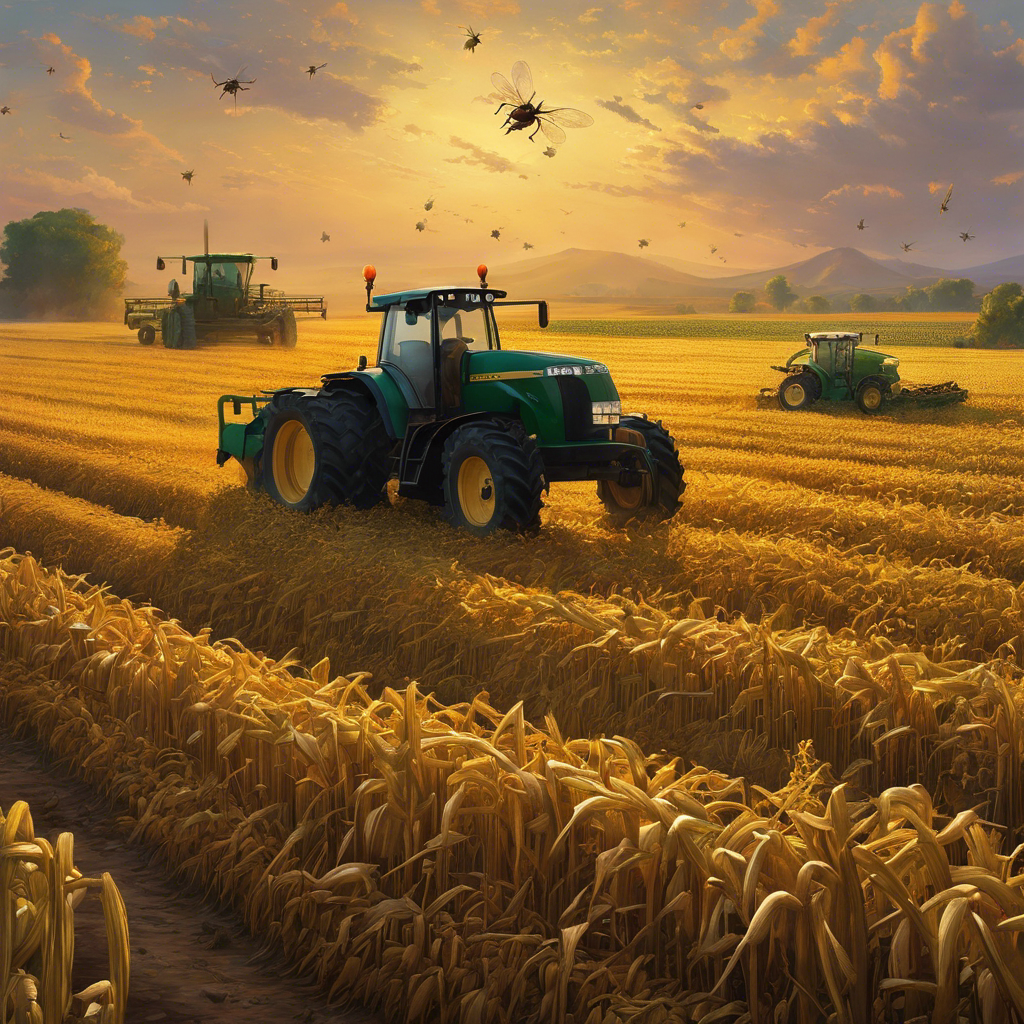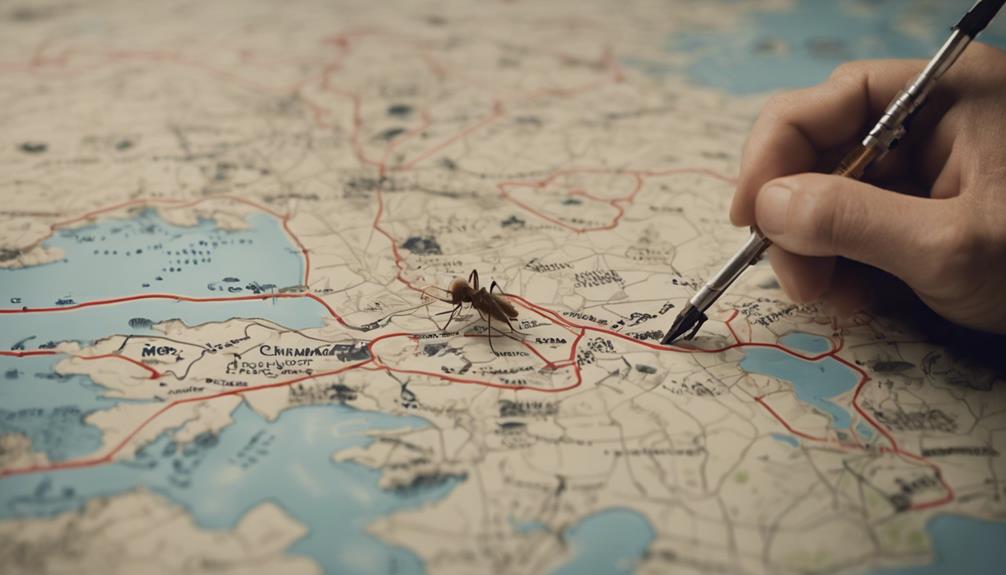The impact of pests on St. George’s agricultural industry has been a matter of concern, as it poses significant challenges and repercussions.
Pests, such as insects, rodents, and birds, can cause extensive damage to crops, leading to economic losses and reduced crop yields. Additionally, pests can transmit diseases to plants and livestock, further exacerbating the indirect damage.
The contamination of stored products by pests renders them unfit for consumption, resulting in revenue loss and potential food security issues. Moreover, pests can disrupt production by causing damage to equipment and machinery, leading to costly repairs and interruptions.
To address these challenges, effective pest control strategies and prevention measures are crucial. By implementing proper pest management practices, St. George’s agricultural industry can mitigate the impact of pests and ensure the sustainability of its agricultural sector.
Key Takeaways
- Pests, such as insects and pest species, can cause economic losses by damaging crops and reducing crop yields.
- Plant diseases transmitted by pests can further worsen the economic losses in the agricultural industry of St. George.
- Integrated Pest Management (IPM), which includes biological control, cultural practices, and judicious use of pesticides, is essential for effective pest control.
- Pests can also impact livestock and animal health, leading to reduced productivity and jeopardizing food security in St. George.
Economic Losses Caused by Pests
The economic losses caused by pests in St. George’s agricultural industry are significant. Insect pests and pest species have a detrimental impact on crop production, leading to crop damage and reduced crop yields. Plant diseases transmitted by pests further exacerbate the economic losses.
These losses not only affect individual farmers but also impact the overall agricultural industry of St. George. Effective pest control measures, such as integrated pest management (IPM), are essential to mitigate these economic losses. IPM involves the use of various strategies, including biological control, cultural practices, and judicious use of pesticides, to minimize pest populations and their impact on crop production.
Effects of Pests on Crop Yields
Pests in St. George’s agricultural industry have a significant impact on crop yields, resulting in substantial losses for farmers and the overall productivity of the sector.
Insects, rodents, birds, and stored product insects (SPIs) all contribute to this problem. Insects directly damage plants by consuming leaves and creating holes in stems, fruit, and roots, leading to reduced crop yields. They can also transmit bacterial, viral, or fungal infections, further affecting crop productivity.
Rodents, such as rats and mice, pose a threat by scavenging and gnawing on seeds, leaves, roots, plants, fruit, and grain, causing significant damage during harvest seasons.
Birds, particularly pigeons, can cause major problems to edible crops, impacting crop yields.
Additionally, SPIs infest grain and commodities, rendering them unfit for human consumption.
To combat these issues, effective pest control strategies are crucial in order to protect agricultural crops and ensure the availability of high-quality raw materials for various industries.
Damages to Livestock and Animal Health
Rodents and insects pose significant threats to the health and well-being of livestock in St. George’s agricultural industry. These pests can directly impact animal health by transmitting diseases and causing injuries. For instance, insects such as ticks and fleas can spread bacterial, viral, and fungal infections to livestock, leading to reduced productivity and even death.
Additionally, rodents like rats and mice can carry parasites, such as lice and mites, that further compromise the well-being of livestock. The damages inflicted by these pests can have far-reaching consequences beyond the agricultural industry. Animal health is closely linked to human health, and the presence of pests can result in contaminated animal products, jeopardizing food security.
Moreover, the economic impact of pest damage extends to the global economy due to reduced livestock production and trade limitations. It is crucial for St. George’s agricultural industry to implement effective pest control measures to protect livestock, ensure food safety, and safeguard the global economy.
Impact of Pests on Food Security
Pest infestations in St. George’s agricultural industry have a significant impact on food security, compromising the availability and quality of crops and livestock products.
Birds, particularly pigeon species, pose potential problems by causing major damages to edible crops. These birds feed on crops such as grains, fruits, and vegetables, reducing the overall yield and availability of food products. Additionally, bird droppings can contaminate the crops with bacteria, fungi, and parasites, posing health risks to consumers. In some cases, bird species may also act as vectors for human diseases, further exacerbating the potential effects on food security.
Controlling bird populations and implementing effective bird management strategies are crucial to mitigate the negative impact on global food production. Research conducted by North American State University has shown that using scare tactics, physical barriers, and bird deterrents can help minimize bird damage to crops.
Moreover, implementing measures to reduce weed seed availability can also contribute to the prevention of bird infestations in agricultural areas, thus safeguarding food security.
Strategies for Pest Control and Prevention
To effectively manage and prevent pest infestations in St. George’s agricultural industry, the implementation of comprehensive and tailored pest control strategies is crucial. Pests and pathogens can cause significant damage to crops, livestock, and stored products, leading to major economic losses.
Developing appropriate strategies for pest control and prevention requires a systematic approach that involves pest risk assessment, decision support tools, and collaboration among scientists and stakeholders. Integrated Pest Management (IPM) approaches, which combine various pest control methods, such as biological controls, cultural practices, and chemical interventions, have proven to be effective in reducing pest populations and minimizing pesticide use.
Additionally, the use of specific pest monitoring techniques and early warning systems can help detect and respond to pest outbreaks promptly. By adopting these strategies, St. George’s agricultural industry can safeguard its productivity and mitigate the negative impacts of pests on food security and economic stability.
Frequently Asked Questions
What Are the Negative Effects of Pests on Agriculture?
Pests in agriculture have a detrimental impact, including economic losses, food insecurity, decreased crop yield, increased pesticide use, damage to infrastructure, spread of diseases, environmental damage, loss of biodiversity, disruption of ecosystems, and increased production costs.
What Is Considered the Most Damaging Agricultural Pest in the World?
The Khapra beetle is considered the most damaging agricultural pest in the world, causing significant global economic impact. Pest management strategies, such as pest resistant crop varieties and integrated pest management approaches, are crucial in mitigating its environmental consequences and ensuring food security. The beetle is also a vector for disease transmission and has implications for small scale farmers. Pesticide use and resistance are major concerns, and the beetle’s impact on crop yields and quality cannot be ignored.
What Is a Notorious Pest in the Agricultural Industry?
A notorious pest in the agricultural industry is the Khapra beetle, known for causing significant grain damage and resistance to insecticides. Integrated pest management, pest-resistant crops, and pest surveillance techniques are crucial for effective pest control and minimizing the economic impact on the agricultural industry.
How Do Insects Pests Affect Crop Growth?
Insect pests can negatively impact crop growth by directly damaging plants and transmitting diseases. Effective pest management techniques, including the use of beneficial insects and sustainable pest control methods, are essential for minimizing economic losses and ensuring crop productivity. Additionally, climate change can affect pest populations, while genetic resistance in crops, integrated pest management strategies, early pest detection and prevention, and the use of technology play significant roles in controlling pests. It is also important to consider the implications of pesticide use on human health.




